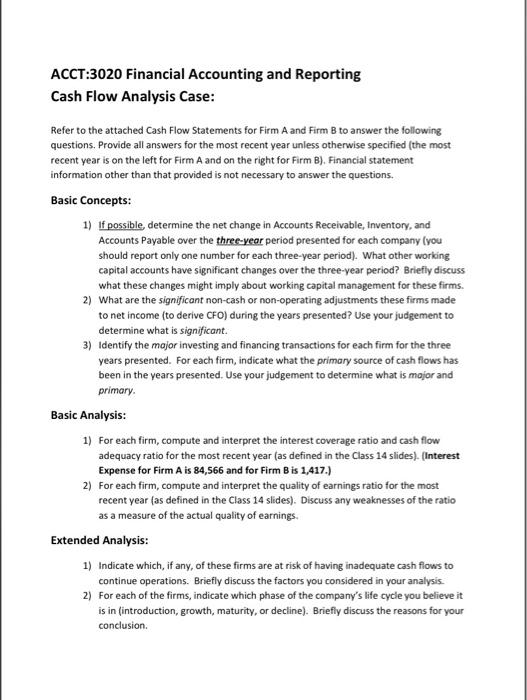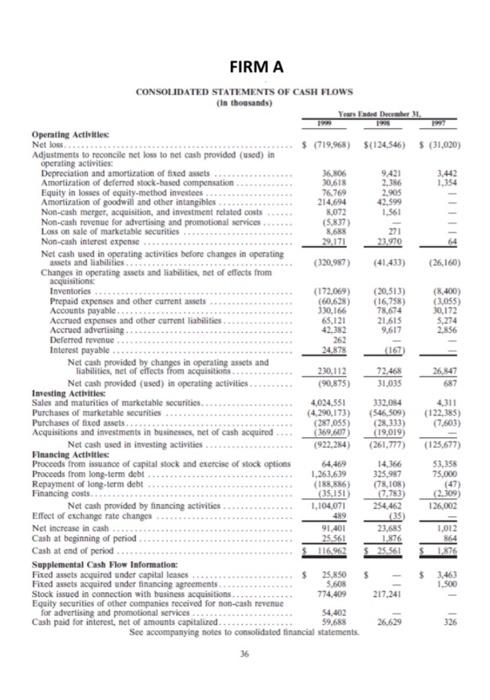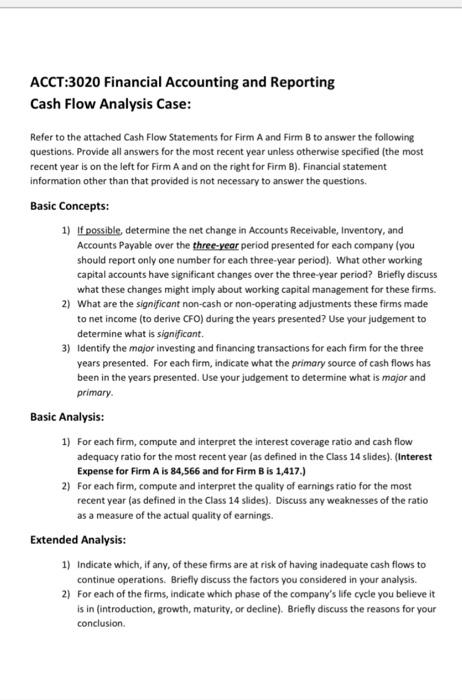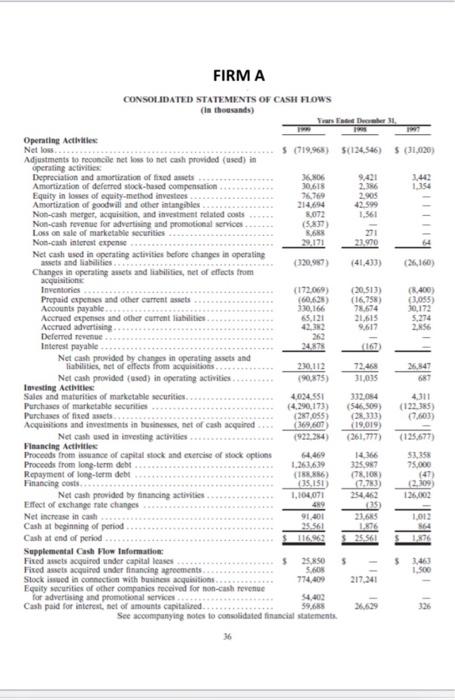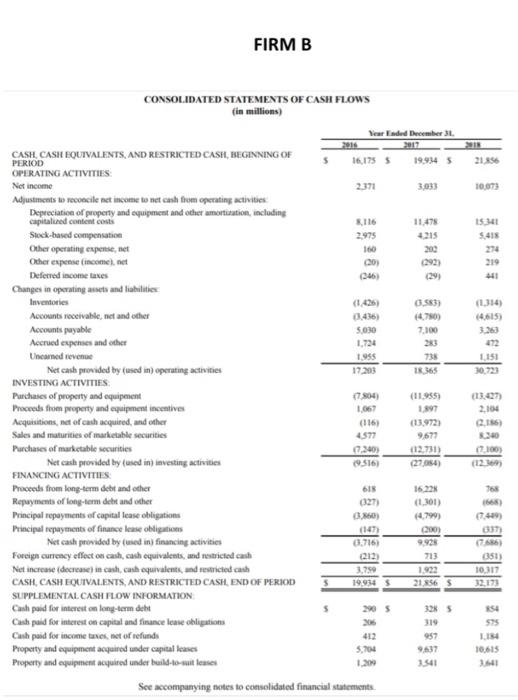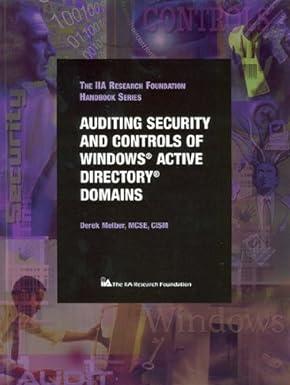Basic Concepts: 1) If possible, determine the net change in Accounts Receivable, Inventory, and Accounts Payable over the three-year period presented for each company (you should report only one number for each three-year period). What other working capital accounts have significant changes over the three-year period? Briefly discuss what these changes might imply about working capital management for these firms. 2) What are the significant non-cash or non-operating adjustments these firms made to net income (to derive CFO) during the years presented? Use your judgement to determine what is significant. 3) Identify the major investing and financing transactions for each firm for the three years presented. For each firm, indicate what the primary source of cash flows has been in the years presented. Use your judgement to determine what is mojor and primary. Basic Analysis: 1) For each firm, compute and interpret the interest coverage ratio and cash flow adequacy ratio for the most recent year (as defined in the Class 14 slides). (Interest Expense for Firm A is 84,566 and for Firm B is 1,417.) 2) For each firm, compute and interpret the quality of earnings ratio for the most recent year (as defined in the Class 14 slides). Discuss any weaknesses of the ratio as a measure of the actual quality of earnings. Extended Analysis: 1) Indicate which, if any, of these firms are at risk of having inadequate cash flows to continue operations. Briefly discuss the factors you considered in your analysis. 2) For each of the firms, indicate which phase of the company's life cycle you believe it is in (introduction, growth, maturity, or decline). Briefly discuss the reasons for your conclusion. FIRM A CONsOT.1DATED STATYMIENTS OF CASH H.OWS (in thousandv) FIRM B CONSOL.IDATED STATEMENTS OF CASII FLOWS Basic Concepts: 1) If possible determine the net change in Accounts Receivable, Inventory, and Accounts Payable over the three-year period presented for each company (you should report only one number for each three-year period). What other working capital accounts have significant changes over the three-year period? Briefly discuss what these changes might imply about working capital management for these firms. 2) What are the significant non-cash or non-operating adjustments these firms made to net income (to derive CFO) during the years presented? Use your judgement to determine what is significant. 3) Identify the major investing and financing transactions for each firm for the three years presented. For each firm, indicate what the primary source of cash flows has been in the years presented. Use your judgement to determine what is major and primary. Basic Analysis: 1) For each firm, compute and interpret the interest coverage ratio and cash flow adequacy ratio for the most recent year (as defined in the Class 14 slides). (Interest Expense for Firm A is 84,566 and for Firm B is 1,417.) 2) For each firm, compute and interpret the quality of earnings ratio for the most recent year (as defined in the Class 14 slides). Discuss any weaknesses of the ratio as a measure of the actual quality of earnings. Extended Analysis: 1) Indicate which, if any, of these firms are at risk of having inadequate cash flows to continue operations. Briefly discuss the factors you considered in your analysis. 2) For each of the firms, indicate which phase of the company's life cycle you believe it is in (introduction, growth, maturity, or decline). Briefly discuss the reasons for your conclusion. FIRM A CONSO.IDATED STATEMENTS OF CASH H1OWS FIRM B CONSOL.IDATED STATEMENTS OF CASH FLOWS Basic Concepts: 1) If possible, determine the net change in Accounts Receivable, Inventory, and Accounts Payable over the three-year period presented for each company (you should report only one number for each three-year period). What other working capital accounts have significant changes over the three-year period? Briefly discuss what these changes might imply about working capital management for these firms. 2) What are the significant non-cash or non-operating adjustments these firms made to net income (to derive CFO) during the years presented? Use your judgement to determine what is significant. 3) Identify the major investing and financing transactions for each firm for the three years presented. For each firm, indicate what the primary source of cash flows has been in the years presented. Use your judgement to determine what is mojor and primary. Basic Analysis: 1) For each firm, compute and interpret the interest coverage ratio and cash flow adequacy ratio for the most recent year (as defined in the Class 14 slides). (Interest Expense for Firm A is 84,566 and for Firm B is 1,417.) 2) For each firm, compute and interpret the quality of earnings ratio for the most recent year (as defined in the Class 14 slides). Discuss any weaknesses of the ratio as a measure of the actual quality of earnings. Extended Analysis: 1) Indicate which, if any, of these firms are at risk of having inadequate cash flows to continue operations. Briefly discuss the factors you considered in your analysis. 2) For each of the firms, indicate which phase of the company's life cycle you believe it is in (introduction, growth, maturity, or decline). Briefly discuss the reasons for your conclusion. FIRM A CONsOT.1DATED STATYMIENTS OF CASH H.OWS (in thousandv) FIRM B CONSOL.IDATED STATEMENTS OF CASII FLOWS Basic Concepts: 1) If possible determine the net change in Accounts Receivable, Inventory, and Accounts Payable over the three-year period presented for each company (you should report only one number for each three-year period). What other working capital accounts have significant changes over the three-year period? Briefly discuss what these changes might imply about working capital management for these firms. 2) What are the significant non-cash or non-operating adjustments these firms made to net income (to derive CFO) during the years presented? Use your judgement to determine what is significant. 3) Identify the major investing and financing transactions for each firm for the three years presented. For each firm, indicate what the primary source of cash flows has been in the years presented. Use your judgement to determine what is major and primary. Basic Analysis: 1) For each firm, compute and interpret the interest coverage ratio and cash flow adequacy ratio for the most recent year (as defined in the Class 14 slides). (Interest Expense for Firm A is 84,566 and for Firm B is 1,417.) 2) For each firm, compute and interpret the quality of earnings ratio for the most recent year (as defined in the Class 14 slides). Discuss any weaknesses of the ratio as a measure of the actual quality of earnings. Extended Analysis: 1) Indicate which, if any, of these firms are at risk of having inadequate cash flows to continue operations. Briefly discuss the factors you considered in your analysis. 2) For each of the firms, indicate which phase of the company's life cycle you believe it is in (introduction, growth, maturity, or decline). Briefly discuss the reasons for your conclusion. FIRM A CONSO.IDATED STATEMENTS OF CASH H1OWS FIRM B CONSOL.IDATED STATEMENTS OF CASH FLOWS
